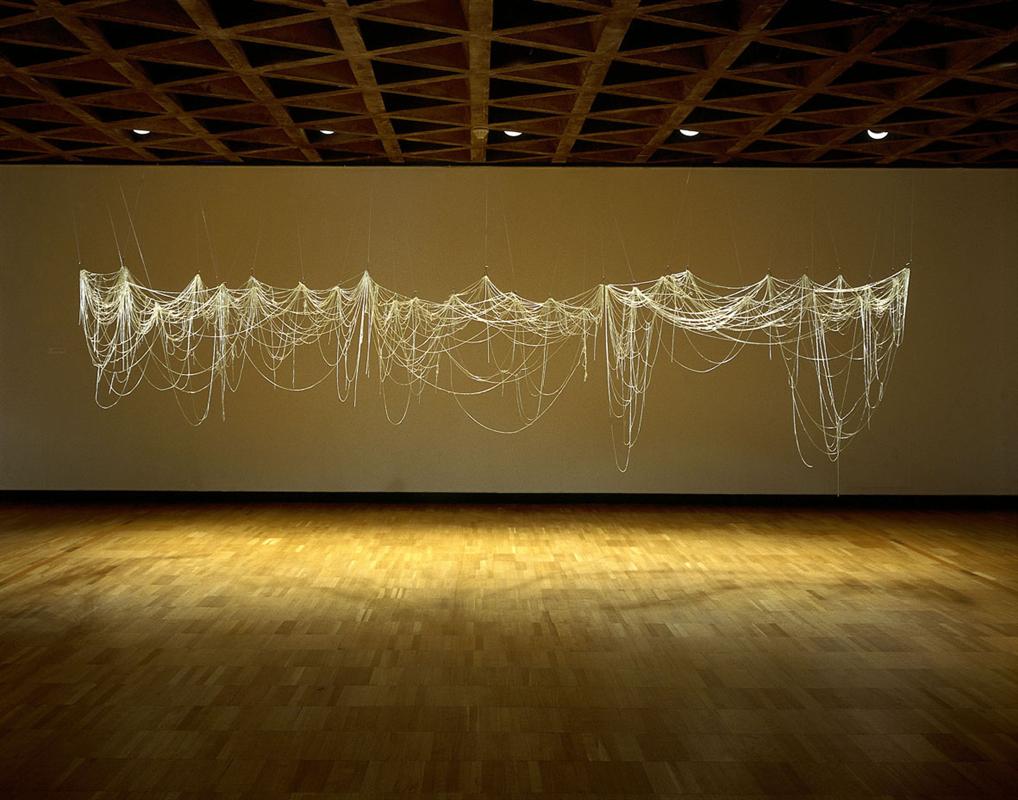Right After is one of the most famous works created by German-born American artist Eva Hesse. She was one of the artists who ushered in the Post-Minimalism art movement in 60’s. And she’s known for her pioneering work using materials such as fiberglass, latex, rubber, transparent plastic, strings, vinyl, etc.
She used new these new materials to give vitality to the pieces with the aim to contrast the minimalist neutrality. What she did was highlight the aspects that make her work go beyond of minimal art, trying a new and exotic way with sensual and dynamic components. With this, she opened new paths in terms of colour (ranging from muted tones to acid), shapes (indefinite forms) and materials without renouncing the formal basis of figurative art.
Right After

- Right After by Eva Hesse (1969)
This was one of the two pieces hung from the ceiling that she created. It was a collaboration with the artist Doug John. At that time, she was very ill with a brain tumour. She dipped one to two hundred feet lengths of fiberglass cord into buckets of latex and hung it on S-shaped hooks cut from ordinary clothes hangers and suspended the piece in the air from the ceiling to dry.
At that time, she was one of few artists that experimented with latex and was not sure what would happen. The latex would either drip off the piece or dry and stick to it.
Right After caught everyone’s attention because it was completely handmade and used materials from everyday life, which was very different from Minimalism.
It was moved from gallery to gallery which disturbed Hesse because she wasn’t sure what the exact changes would be during each transition, she believed her studio was part of it and putting it into a gallery would only change people’s perspective. She didn’t like how galleries used dramatic lighting effects, that in her opinion would unfortunately take away the shadows she would see in her studio.
From afar, this piece has a weightless and droopy effect. And in my opinion it is very poetic, it recreated sensory experiences that in a first moment made it the object of an aesthetic experience, before being interpreted with an intellectual reading.
“Eva and I made this piece the day after she came home to the Bowery, after her first operation. Her head was wrapped with surgical gauze with a trickle of blood running down her cheek. It was probably the most exhilarating hours we ever spent together. Laughing and giggling like infants. The result is in another realm. I believe it is her best piece. … It was made in response to me explaining to Eva, before she went to the hospital, that fiberglass came in the form of a continuous band of hundreds of tiny glass fibres that could be hung after saturating them in resin, to make droopy solid shapes. I bought a spool of this continuous strand roving while she was in the hospital. When she knew the time that she would be coming home, she called me, as I was staying at her studio at the time, and asked me to hang a bunch of bent coat hanger hooks from the ceiling across a wide area. The next day made history. On permanent display at the Milwaukee Art Museum.”
Doug John
References:
- Milwaukee Art Museum – Right After
- Art History 207 – Right After
- The Guardian – All about Eva
- Doug John Sculpture – Eva Hesse connection
- The art story – Post-Minimalism movement
- Wikiart – Eva Hesse
- Wikipedia – Eva Hesse
- Book: Reckitt, H. Phelan, P. 2012. Art and Feminism. Phaidon

Discover more from Women'n Art
Subscribe to get the latest posts sent to your email.





Is this the same artist that created the instalation made for Plaza Mayor in Madrid earlier this year?
LikeLiked by 1 person
No, that artist is called Janet Echelman.
LikeLike